brake sensor TOYOTA PRIUS 2017 4.G Quick Reference Guide
[x] Cancel search | Manufacturer: TOYOTA, Model Year: 2017, Model line: PRIUS, Model: TOYOTA PRIUS 2017 4.GPages: 56, PDF Size: 4.12 MB
Page 3 of 56
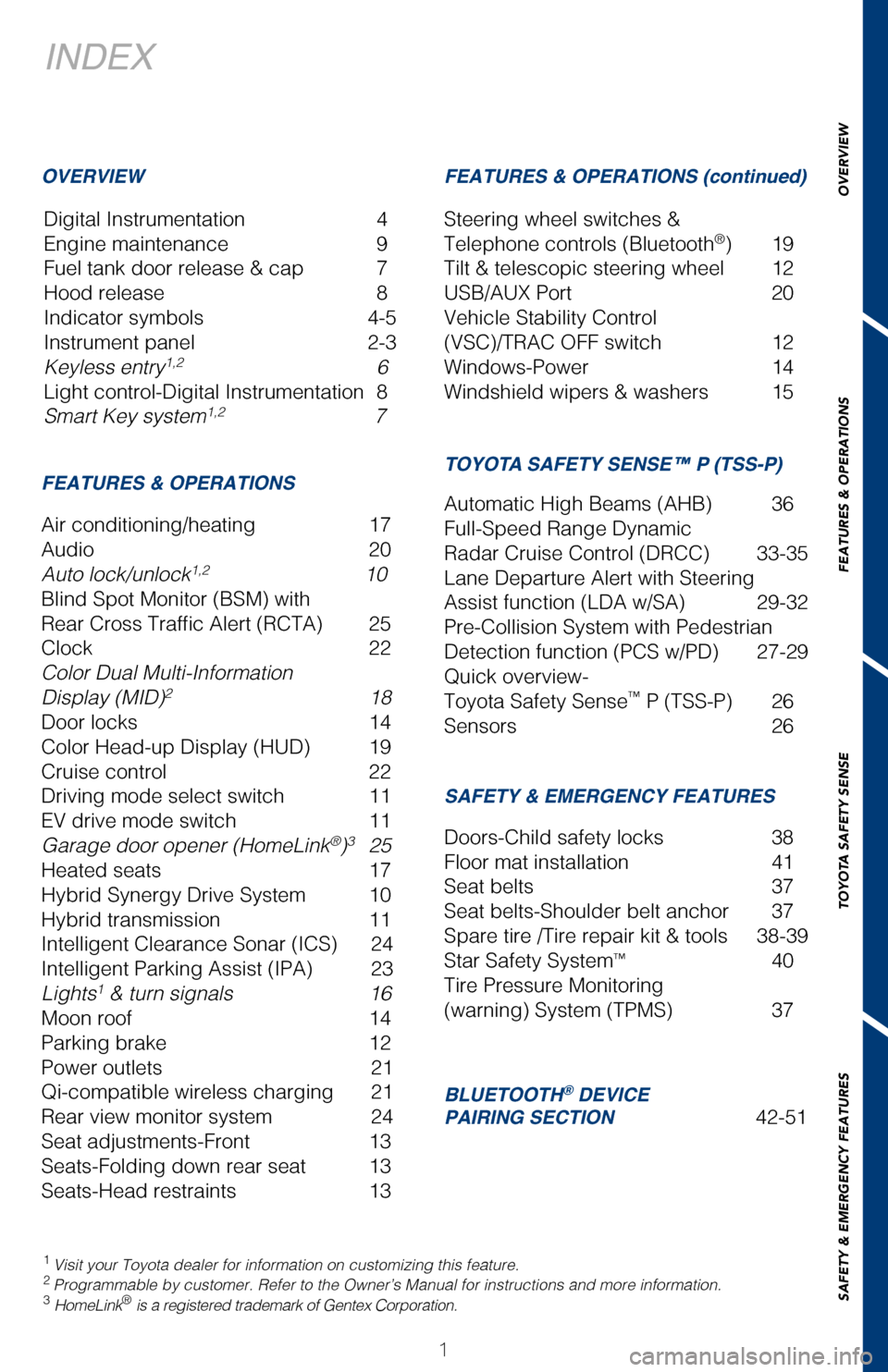
OVERVIEW
FEATURES & OPERATIONS
TOYOTA SAFETY SENSE
SAFETY & EMERGENCY FEATURES
1
INDEX
Digital Instrumentation 4
Engine maintenance 9
Fuel tank door release & cap 7
Hood release 8
Indicator symbols 4-5
Instrument panel 2-3
Keyless entry
1,2 6
Light control-Digital Instrumentation 8
Smart Key system
1,2 7
1 Visit your Toyota dealer for information on customizing this feature.2 Programmable by customer. Refer to the Owner’s Manual for instruction\
s and more information.3 HomeLink® is a registered trademark of Gentex Corporation.
OVERVIEW FEATURES & OPERATIONS (continued)
FEATURES & OPERATIONS
SAFETY & EMERGENCY FEATURES TOYOTA SAFETY SENSE™ P (TSS-P)
Air conditioning/heating 17
Audio 20
Auto lock/unlock
1,2 10
Blind Spot Monitor (BSM) with
Rear Cross Traffic Alert (RCTA) 25
Clock 22
Color Dual Multi-Information
Display (MID)
2 18
Door locks 14
Color Head-up Display (HUD) 19
Cruise control 22
Driving mode select switch 11
EV drive mode switch 11
Garage door opener (HomeLink
®)3 25
Heated seats 17
Hybrid Synergy Drive System 10
Hybrid transmission 11
Intelligent Clearance Sonar (ICS) 24
Intelligent Parking Assist (IPA) 23
Lights
1 & turn signals 16
Moon roof 14
Parking brake 12
Power outlets 21
Qi-compatible wireless charging 21
Rear view monitor system 24
Seat adjustments-Front 13
Seats-Folding down rear seat 13
Seats-Head restraints 13Doors-Child safety locks
38
Floor mat installation 41
Seat belts 37
Seat belts-Shoulder belt anchor 37
Spare tire /Tire repair kit & tools 38-39
Star Safety System
™ 40
Tire Pressure Monitoring
(warning) System (TPMS) 37 Automatic High Beams (AHB) 36
Full-Speed Range Dynamic
Radar Cruise Control (DRCC) 33-35
Lane Departure Alert with Steering
Assist function (LDA w/SA) 29-32
Pre-Collision System with Pedestrian
Detection function (PCS w/PD) 27-29
Quick overview-
Toyota Safety Sense
™ P (TSS-P) 26
Sensors 26
Steering wheel switches &
Telephone controls (Bluetooth
®) 19
Tilt & telescopic steering wheel 12
USB/AUX Port 20
Vehicle Stability Control
(VSC)/TRAC OFF switch 12
Windows-Power 14
Windshield wipers & washers 15
PRIUS 2017
This Quick Reference Guide is a summary of basic vehicle
operations. It contains brief descriptions of fundamental
operations so you can locate and use the vehicle’s main
equipment quickly and easily.
The Quick Reference Guide is not intended as a substitute for
the Owner’s Manual located in your vehicle’s glove box. We
strongly encourage you to review the Owner’s Manual and
supplementary manuals so you will have a better understanding
of your vehicle’s capabilities and limitations.
Your dealership and the entire staff of Toyota Motor Sales,
U.S.A., Inc. wish you many years of satisfied driving in your new
Prius.
A word about safe vehicle operations
This Quick Reference Guide is not a full description of Prius operations\
. Every
Prius owner should review the Owner’s Manual that accompanies this ve\
hicle.
Pay special attention to the boxed information highlighted in color throughout
the Owner’s Manual. Each box contains safe operating instructions to \
help you
avoid injury or equipment malfunction.
All information in this Quick Reference Guide is current at the time of \
printing.
Toyota reserves the right to make changes at any time without notice.
BLUETOOTH® DEVICE
PAIRING SECTION 42-51
2017_Prius_D6_1.indd 19/25/16 2:37 AM
Page 24 of 56
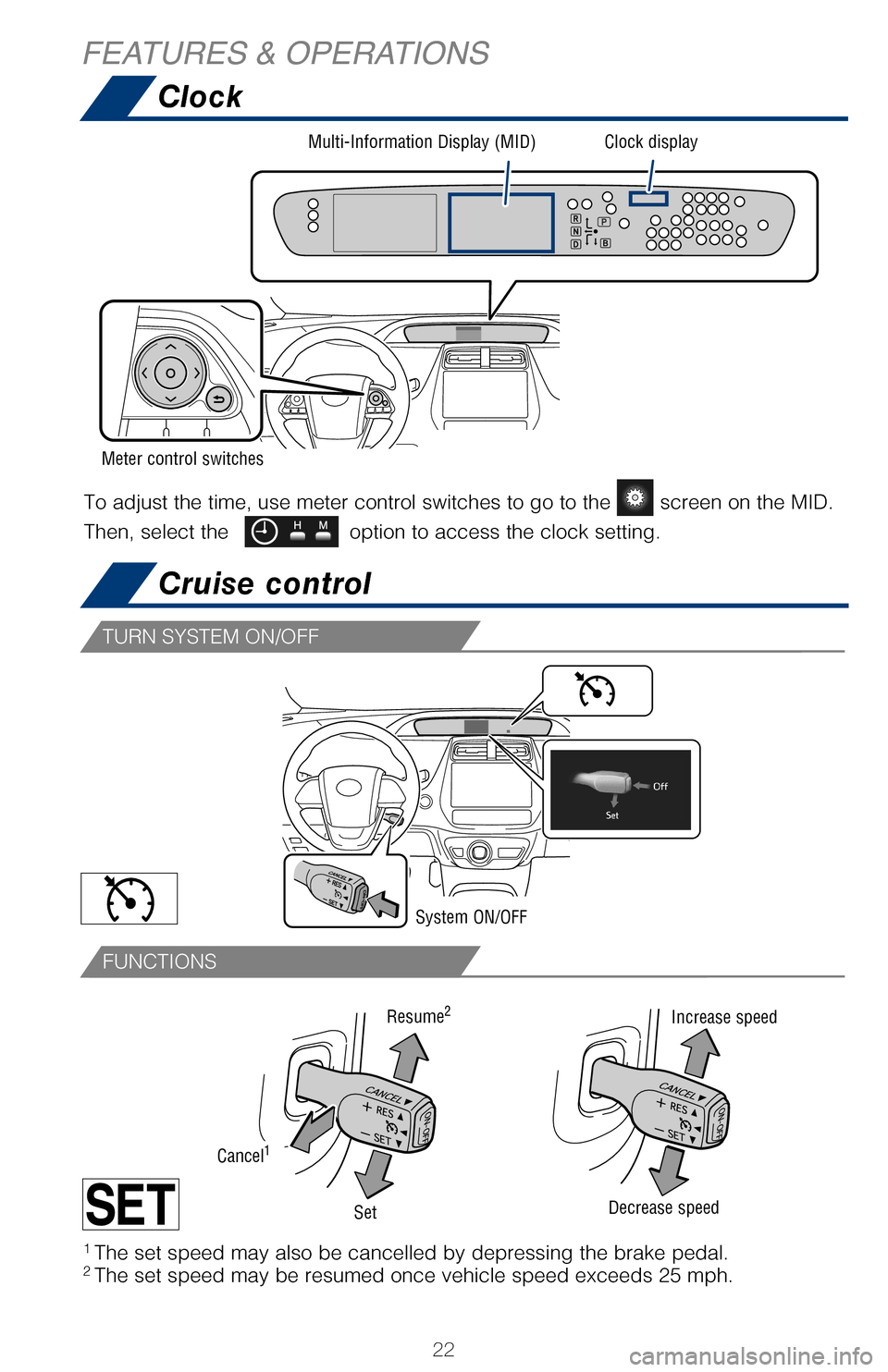
22
Clock
Cruise control
If the sensors detect an obstacle, the buzzer and MID display informs the \
driver of
the approximate position and distance of the obstacle by illuminating conti\
nuously
(far) or blinking (near).
Note: Use
in the Multi-Information Display (MID) to change settings. The
system will continue in the last state it was in (ON or OFF) when the engine\
is
started again.
Refer to section S-APGS (Simple Advanced Parking Guidance System) in the
Owner’s Manual for more details.
1 The set speed may also be cancelled by depressing the brake pedal.2 The set speed may be resumed once vehicle speed exceeds 25 mph.
To adjust the time, use meter control switches to go to the screen on the MID.
Then, select the
option to access the clock setting.
TURN SYSTEM ON/OFF
FUNCTIONS
FEATURES & OPERATIONS
System ON/OFF
Increase speed
Multi-Information Display (MID)
Clock display
Meter control switches
Decrease speed
Cancel1
Resume2
Set
2017_Prius_D6_1.indd 229/25/16 2:38 AM
Page 25 of 56
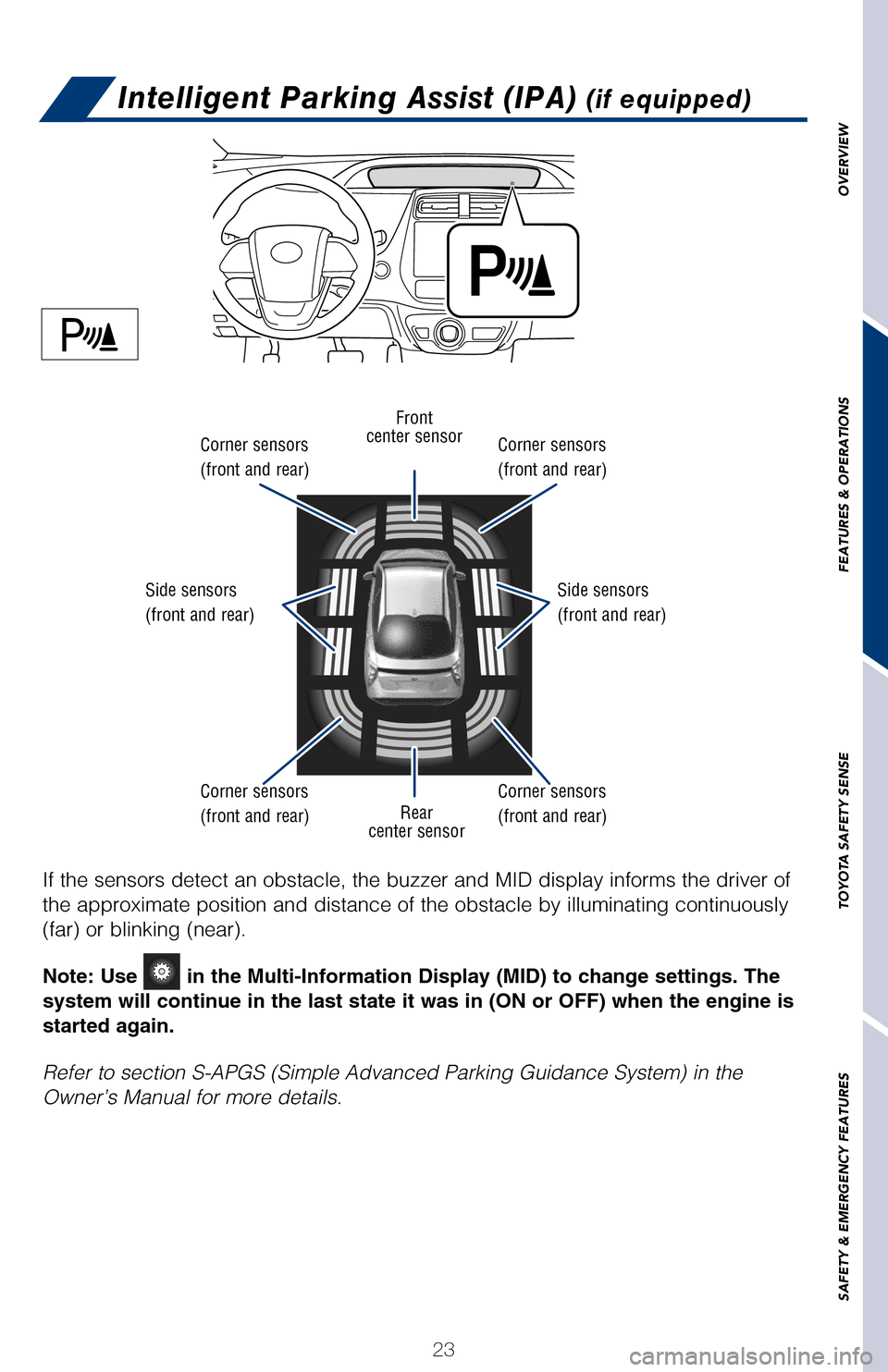
OVERVIEW
FEATURES & OPERATIONS
TOYOTA SAFETY SENSE
SAFETY & EMERGENCY FEATURES
23
Intelligent Parking Assist (IPA) (if equipped)
Cruise control
If the sensors detect an obstacle, the buzzer and MID display informs th\
e driver of
the approximate position and distance of the obstacle by illuminating co\
ntinuously
(far) or blinking (near).
Note: Use
in the Multi-Information Display (MID) to change settings. The
system will continue in the last state it was in (ON or OFF) when the \
engine is
started again.
Refer to section S-APGS (Simple Advanced Parking Guidance System) in t\
he
Owner’s Manual for more details.
Front
center sensor
Rear
center sensor
1 The set speed may also be cancelled by depressing the brake pedal.2 The set speed may be resumed once vehicle speed exceeds 25 mph.
To adjust the time, use meter control switches to go to the
screen on the MID.
Then, select the
option to access the clock setting.
Corner sensors
(front and rear)
Corner sensors
(front and rear)
Side sensors
(front and rear)
Side sensors
(front and rear)
Corner sensors
(front and rear)
Corner sensors
(front and rear)
Increase speed
2017_Prius_D6_1.indd 239/25/16 2:38 AM
Page 26 of 56
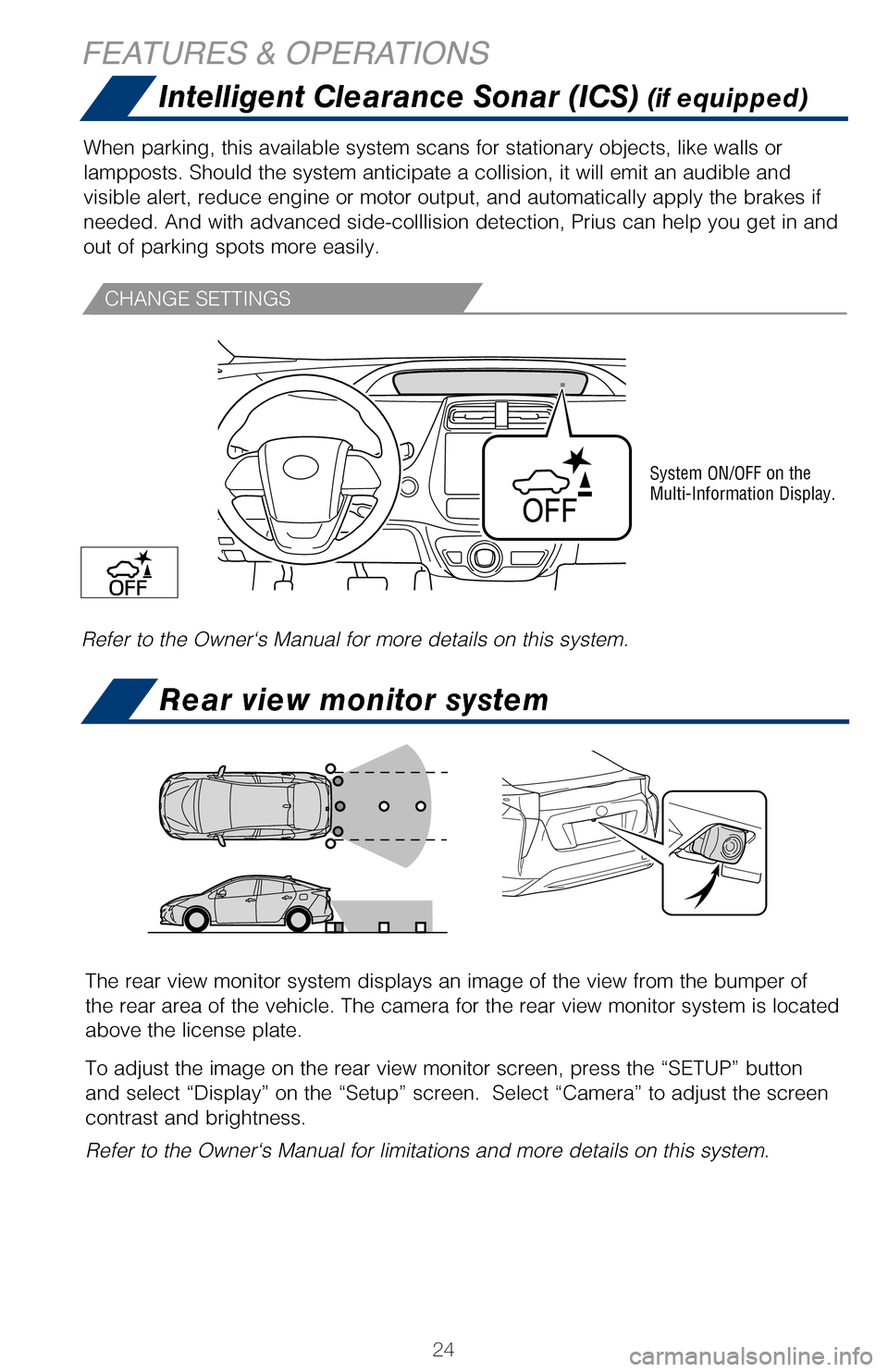
24
Intelligent Clearance Sonar (ICS) (if equipped)
When parking, this available system scans for stationary objects, like w\
alls or
lampposts. Should the system anticipate a collision, it will emit an aud\
ible and
visible alert, reduce engine or motor output, and automatically apply th\
e brakes if
needed. And with advanced side-colllision detection, Prius can help you \
get in and
out of parking spots more easily.
Refer to the Owner‘s Manual for more details on this system.
System ON/OFF on the
Multi-Information Display.
The Blind Spot Monitor is a system that has two functions:
• The Blind Spot Monitor function (assists the driver in making the decision when changing lanes)
• The Rear Cross Traffic Alert function (assists the driver when backing up)
The system is designed to use radar sensors to detect vehicles traveling in the
Prius’ blind spot and advises the driver of the vehicles’ presence\
via the outside
rear view mirror indicators.
Note: Use
in the Multi-Information Display (MID) to change settings. The
system will continue in the last state it was in (ON or OFF) when the \
engine is
started again.
Refer to the Owner‘s Manual for limitations and more details on this \
system before
attempting to use it.
Garage door openers manufactured under license from HomeLink
®* can be
programmed to operate garage doors, estate gates, security lighting, etc\
.
Refer to “Garage door opener,” Section 3-5 in the Owner’s Manua\
l for more
details.
For programming assistance, contact HomeLink
® at 1-800-355-3515, or visit http://
www.homelink.com.
* HomeLink® is a registered trademark of Johnson Controls, Inc.
CHANGE SETTINGS
FEATURES & OPERATIONS
Rear view monitor system
The rear view monitor system displays an image of the view from the bumper of
the rear area of the vehicle. The camera for the rear view monitor system is located
above the license plate.
To adjust the image on the rear view monitor screen, press the “SETUP” button
and select “Display” on the “Setup” screen. Select “Camera” to adjust the screen
contrast and brightness.
Refer to the Owner‘s Manual for limitations and more details on this \
system.
2017_Prius_D6_1.indd 249/25/16 2:38 AM
Page 27 of 56
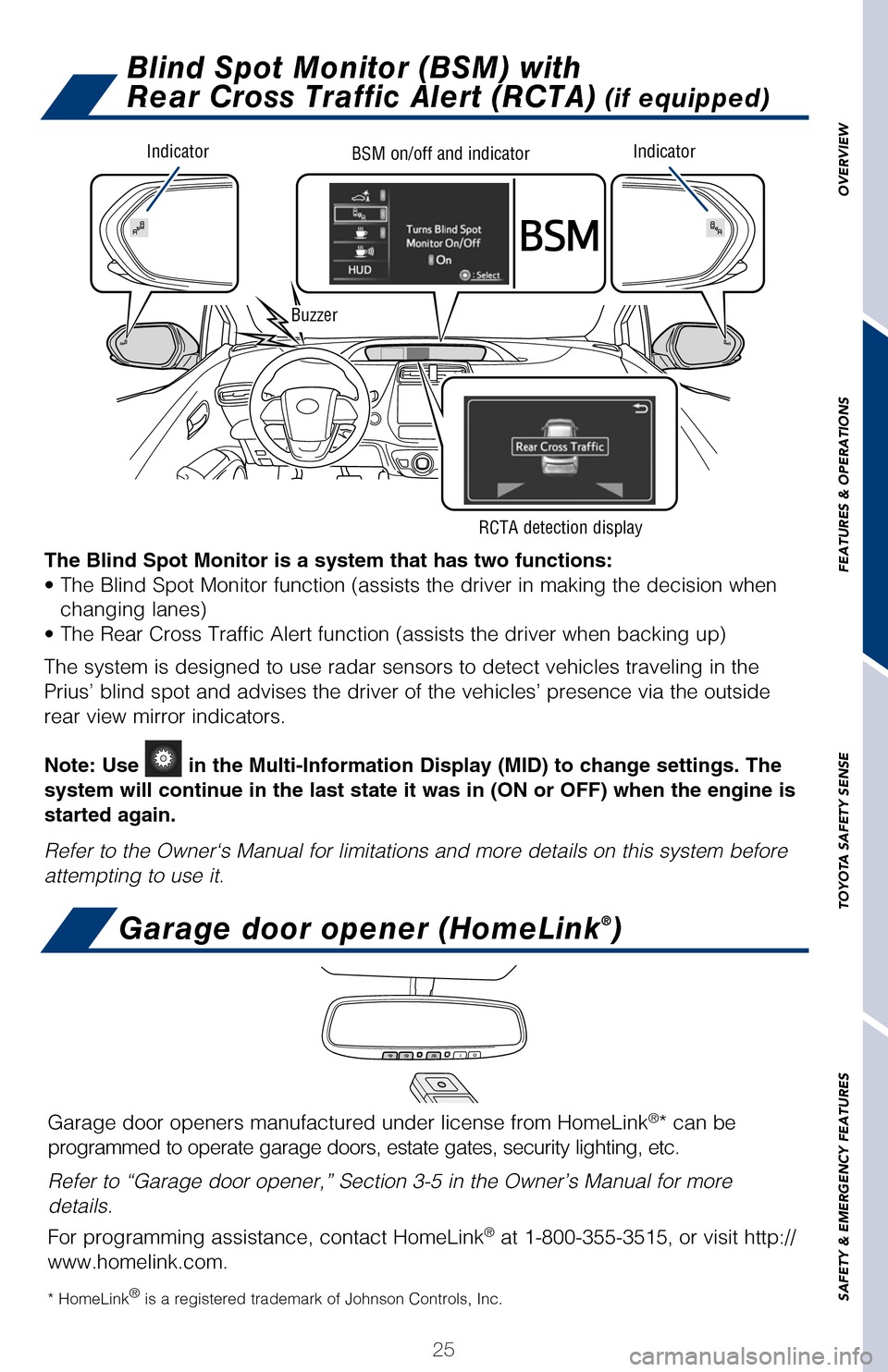
OVERVIEW
FEATURES & OPERATIONS
TOYOTA SAFETY SENSE
SAFETY & EMERGENCY FEATURES
25
Intelligent Clearance Sonar (ICS) (if equipped)
Blind Spot Monitor (BSM) with
Rear Cross Traffic Alert (RCTA)
(if equipped)
Garage door opener (HomeLink®)
When parking, this available system scans for stationary objects, like w\
alls or
lampposts. Should the system anticipate a collision, it will emit an aud\
ible and
visible alert, reduce engine or motor output, and automatically apply th\
e brakes if
needed. And with advanced side-colllision detection, Prius can help you \
get in and
out of parking spots more easily.
Refer to the Owner‘s Manual for more details on this system.
System ON/OFF on the
Multi-Information Display.
The Blind Spot Monitor is a system that has two functions:
• The Blind Spot Monitor function (assists the driver in making the decision when changing lanes)
• The Rear Cross Traffic Alert function (assists the driver when backing up)
The system is designed to use radar sensors to detect vehicles traveling in the
Prius’ blind spot and advises the driver of the vehicles’ presence\
via the outside
rear view mirror indicators.
Note: Use
in the Multi-Information Display (MID) to change settings. The
system will continue in the last state it was in (ON or OFF) when the \
engine is
started again.
Refer to the Owner‘s Manual for limitations and more details on this \
system before
attempting to use it.
Garage door openers manufactured under license from HomeLink®* can be
programmed to operate garage doors, estate gates, security lighting, etc\
.
Refer to “Garage door opener,” Section 3-5 in the Owner’s Manua\
l for more
details.
For programming assistance, contact HomeLink
® at 1-800-355-3515, or visit http://
www.homelink.com.
* HomeLink® is a registered trademark of Johnson Controls, Inc.
Rear view monitor system
The rear view monitor system displays an image of the view from the bumper of
the rear area of the vehicle. The camera for the rear view monitor system is located
above the license plate.
To adjust the image on the rear view monitor screen, press the “SETUP” button
and select “Display” on the “Setup” screen. Select “Camera” to adjust the screen
contrast and brightness.
Refer to the Owner‘s Manual for limitations and more details on this \
system.
IndicatorIndicatorBSM on/off and indicator
Buzzer
RCTA detection display
2017_Prius_D6_1.indd 259/25/16 2:38 AM
Page 28 of 56
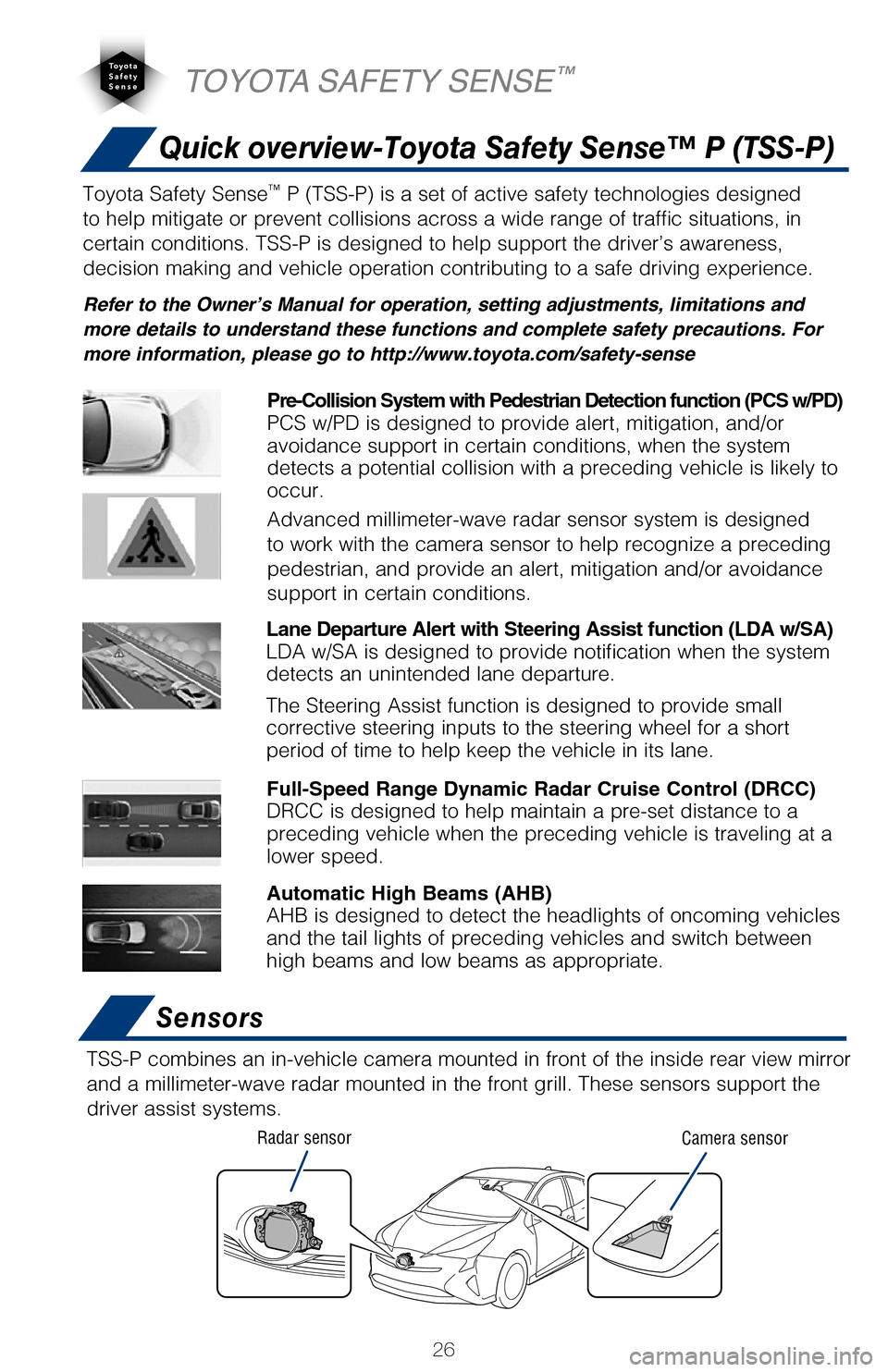
26
Quick overview-Toyota Safety Sense™ P (TSS-P)
Sensors
TSS-P combines an in-vehicle camera mounted in front of the inside rear \
view mirror
and a millimeter-wave radar mounted in the front grill. These sensors su\
pport the
driver assist systems.
Camera sensor
Radar sensor
TOYOTA SAFETY SENSE™
The Pre-Collision System uses a radar sensor and camera sensor to help d\
etect
vehicles and pedestrians in front of your vehicle.
As there is a limit to the degree of recognition accuracy and control pe\
rformance
that this system can provide, do not overly rely on this system. This sy\
stem will not
prevent collisions or lessen collision damage or injury in every situati\
on. Do not use
PCS instead of normal braking operations under any circumstances. Do not\
attempt
to test the operation of the pre-collision system yourself, as the syste\
m may not
operate or engage, possibly leading to an accident. In some situations, \
such as
when driving in inclement weather such as heavy rain, fog, snow or a san\
dstorm or
while driving on a curve and for a few seconds after driving on a curve,\
a vehicle
may not be detected by the radar and camera sensors, preventing the syst\
em from
operating or engaging properly.
Refer to a Toyota Owner’s Manual for a list of additional situations \
in which the
system may not operate properly.
Refer to a Toyota Owner’s Manual for additional information on PCS w/\
PD operation,
settings adjustments, limitations, and precautions before attempting to \
use it. Pre-Collision Warning
When the system determines that the possibility of a frontal collision i\
s high, a
buzzer will sound and a warning message will be displayed on the Multi-I\
nformation
Display (MID) to urge the driver to take evasive action.
Pre-Collision Brake Assist
If the driver notices the hazard and brakes, the system may provide addi\
tional
braking force using Brake Assist. This system may prime the brakes and m\
ay apply
greater braking force in relation to how strongly the brake pedal is dep\
ressed.
Pre-Collision Braking
If the driver does not brake in a set time and the system determines tha\
t the
possibility of a frontal collision with a preceding vehicle is extremely\
high, the
system may automatically apply the brakes, reducing speed in order to he\
lp the
driver reduce the impact and in certain cases avoid the collision.
Toyota Safety Sense™ P (TSS-P) is a set of active safety technologies designed
to help mitigate or prevent collisions across a wide range of traffic situations, in
certain conditions. TSS-P is designed to help support the driver’s aw\
areness,
decision making and vehicle operation contributing to a safe driving exp\
erience.
Refer to the Owner’s Manual for operation, setting adjustments, limitations and
more details to understand these functions and complete safety precautions. For
more information, please go to http://www.toyota.com/safety-sense
Lane Departure Alert with Steering Assist function (LDA w/SA)
LDA w/SA is designed to provide notification when the system
detects an unintended lane departure.
The Steering Assist function is designed to provide small
corrective steering inputs to the steering wheel for a short
period of time to help keep the vehicle in its lane.
Automatic High Beams (AHB)
AHB is designed to detect the headlights of oncoming vehicles
and the tail lights of preceding vehicles and switch between
high beams and low beams as appropriate.
Pre-Collision System with Pedestrian Detection function (PCS w/PD)
PCS w/PD is designed to provide alert, mitigation, and/or
avoidance support in certain conditions, when the system
detects a potential collision with a preceding vehicle is likely to
occur.
Advanced millimeter-wave radar sensor system is designed
to work with the camera sensor to help recognize a preceding
pedestrian, and provide an alert, mitigation and/or avoidance
support in certain conditions.
Full-Speed Range Dynamic Radar Cruise Control (DRCC)
DRCC is designed to help maintain a pre-set distance to a
preceding vehicle when the preceding vehicle is traveling at a
lower speed.
2017_Prius_D6_1.indd 269/25/16 2:38 AM
Page 29 of 56
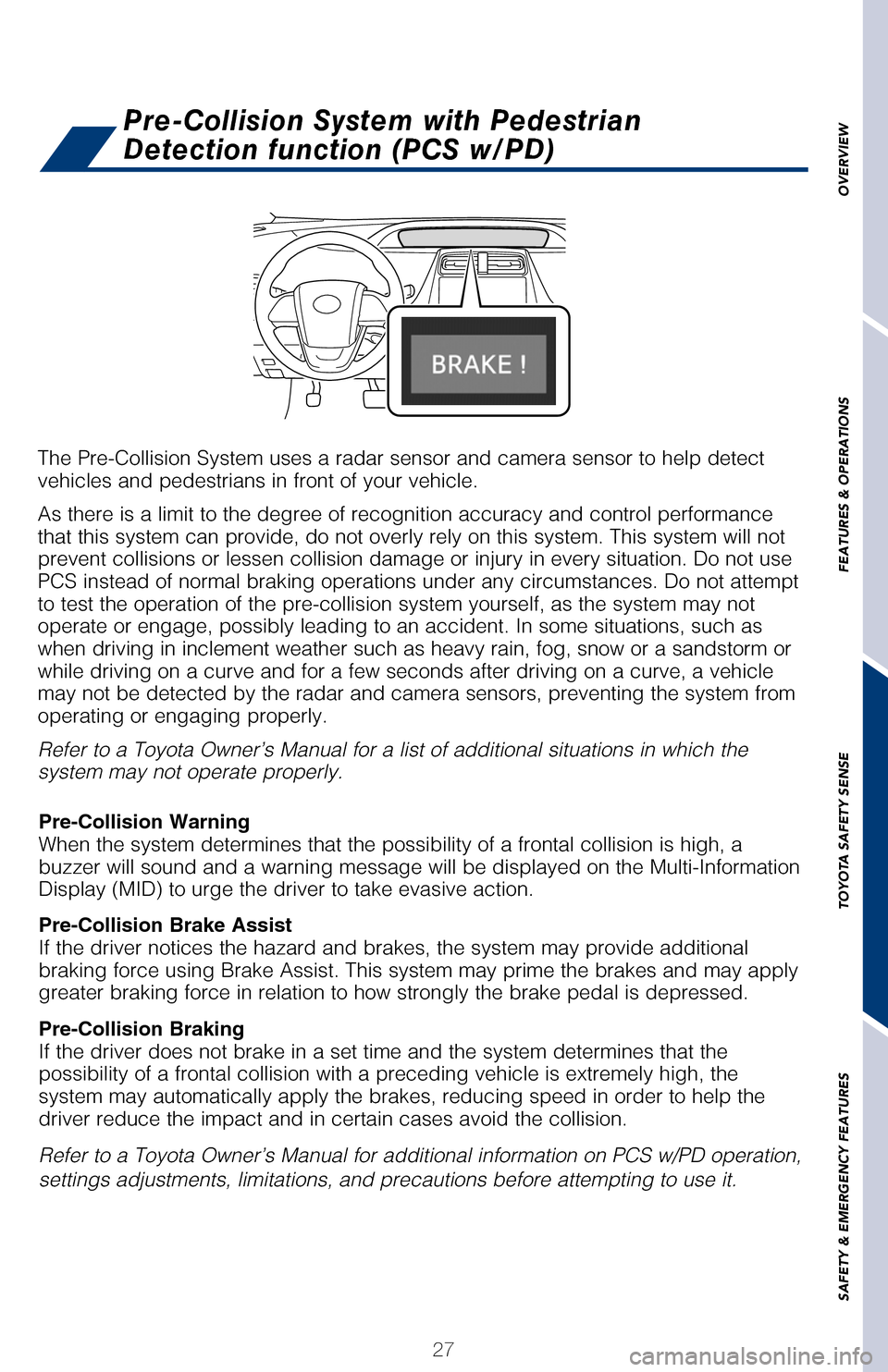
OVERVIEW
FEATURES & OPERATIONS
TOYOTA SAFETY SENSE
SAFETY & EMERGENCY FEATURES
27
Quick overview-Toyota Safety Sense™ P (TSS-P)
Sensors
TSS-P combines an in-vehicle camera mounted in front of the inside rear \
view mirror
and a millimeter-wave radar mounted in the front grill. These sensors su\
pport the
driver assist systems.
Camera sensor
The Pre-Collision System uses a radar sensor and camera sensor to help d\
etect
vehicles and pedestrians in front of your vehicle.
As there is a limit to the degree of recognition accuracy and control pe\
rformance
that this system can provide, do not overly rely on this system. This sy\
stem will not
prevent collisions or lessen collision damage or injury in every situati\
on. Do not use
PCS instead of normal braking operations under any circumstances. Do not\
attempt
to test the operation of the pre-collision system yourself, as the syste\
m may not
operate or engage, possibly leading to an accident. In some situations, \
such as
when driving in inclement weather such as heavy rain, fog, snow or a san\
dstorm or
while driving on a curve and for a few seconds after driving on a curve,\
a vehicle
may not be detected by the radar and camera sensors, preventing the syst\
em from
operating or engaging properly.
Refer to a Toyota Owner’s Manual for a list of additional situations \
in which the
system may not operate properly.
Refer to a Toyota Owner’s Manual for additional information on PCS w/\
PD operation,
settings adjustments, limitations, and precautions before attempting to \
use it. Pre-Collision Warning
When the system determines that the possibility of a frontal collision i\
s high, a
buzzer will sound and a warning message will be displayed on the Multi-I\
nformation
Display (MID) to urge the driver to take evasive action.
Pre-Collision Brake Assist
If the driver notices the hazard and brakes, the system may provide addi\
tional
braking force using Brake Assist. This system may prime the brakes and m\
ay apply
greater braking force in relation to how strongly the brake pedal is dep\
ressed.
Pre-Collision Braking
If the driver does not brake in a set time and the system determines tha\
t the
possibility of a frontal collision with a preceding vehicle is extremely\
high, the
system may automatically apply the brakes, reducing speed in order to he\
lp the
driver reduce the impact and in certain cases avoid the collision.
Pre-Collision System with Pedestrian
Detection function (PCS w/PD)
Toyota Safety Sense™ P (TSS-P) is a set of active safety technologies designed
to help mitigate or prevent collisions across a wide range of traffic situations, in
certain conditions. TSS-P is designed to help support the driver’s aw\
areness,
decision making and vehicle operation contributing to a safe driving exp\
erience.
Refer to the Owner’s Manual for operation, setting adjustments, limitations and
more details to understand these functions and complete safety precautions. For
more information, please go to http://www.toyota.com/safety-sense
Lane Departure Alert with Steering Assist function (LDA w/SA)
LDA w/SA is designed to provide notification when the system
detects an unintended lane departure.
The Steering Assist function is designed to provide small
corrective steering inputs to the steering wheel for a short
period of time to help keep the vehicle in its lane.
Automatic High Beams (AHB)
AHB is designed to detect the headlights of oncoming vehicles
and the tail lights of preceding vehicles and switch between
high beams and low beams as appropriate. Pre-Collision System with Pedestrian Detection function (PCS w/PD)
PCS w/PD is designed to provide alert, mitigation, and/or
avoidance support in certain conditions, when the system
detects a potential collision with a preceding vehicle is likely to
occur.
Advanced millimeter-wave radar sensor system is designed
to work with the camera sensor to help recognize a preceding
pedestrian, and provide an alert, mitigation and/or avoidance
support in certain conditions.
Full-Speed Range Dynamic Radar Cruise Control (DRCC)
DRCC is designed to help maintain a pre-set distance to a
preceding vehicle when the preceding vehicle is traveling at a
lower speed.
2017_Prius_D6_1.indd 279/25/16 2:38 AM
Page 30 of 56
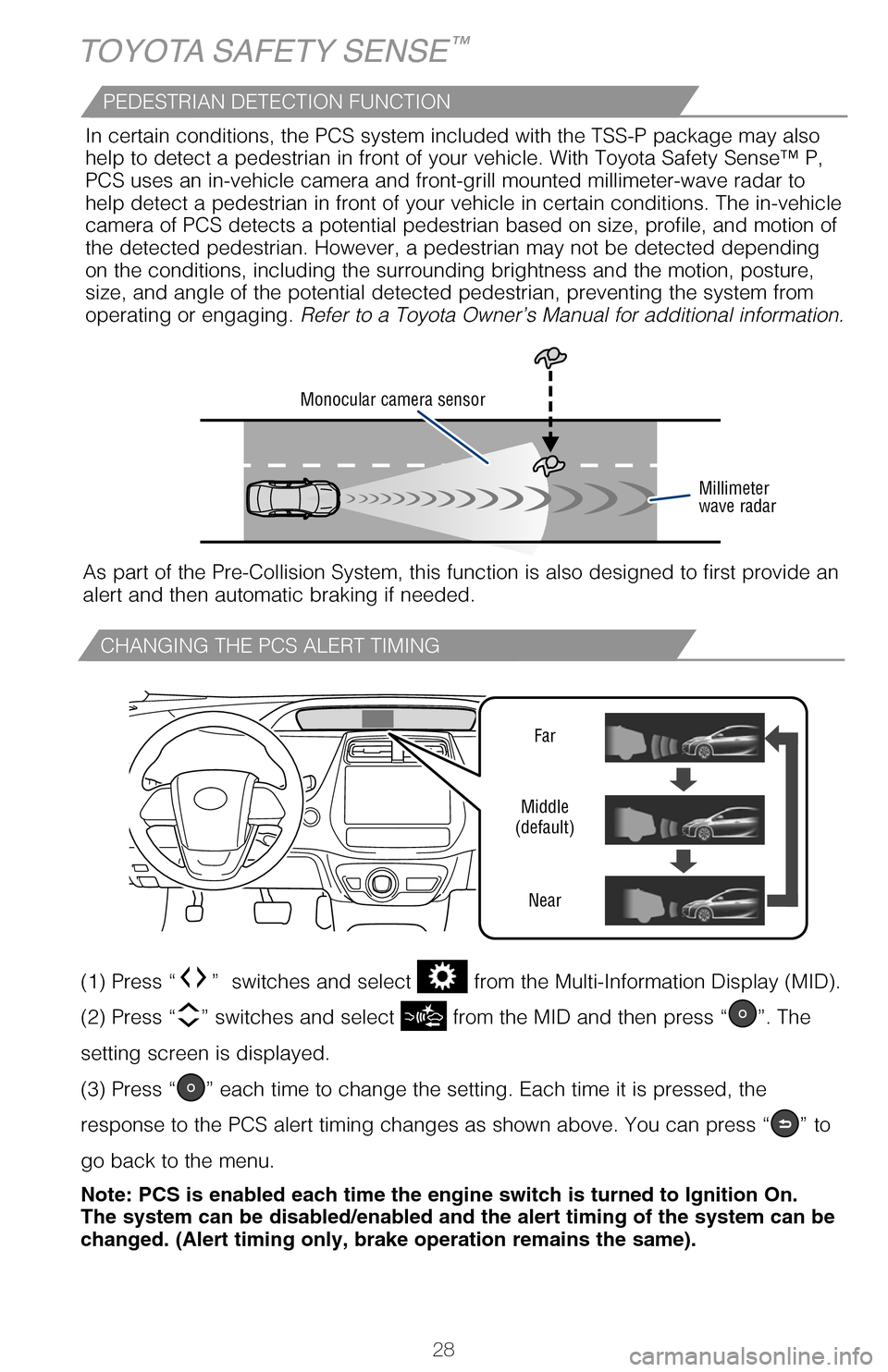
28
CHANGING THE PCS ALERT TIMING
DISABLING THE PRE-COLLISION SYSTEM (PCS)
TOYOTA SAFETY SENSE™
Far
Middle
(default)
Near
LDA in TSS-P uses an in-vehicle camera designed to detect visible white \
and yellow
lane markers in front of the vehicle and the vehicle’s position on th\
e road. If the
system determines that the vehicle is starting to unintentionally deviat\
e from its lane,
the system alerts the driver with an audio and visual alert. When the al\
erts occur, the
driver must check the surrounding road situation and carefully operate t\
he steering
wheel to move the vehicle back to the center part of their lane.
LDA is designed to function at speeds of approximately 32 MPH or higher \
on
relatively straight roadways.
In addition to the alert function, LDA w/SA also features a steering ass\
ist
function. When enabled, if the system determines that the vehicle is on \
a path to
unintentionally depart from its lane, the system may provide small corrective steering
inputs to the steering wheel for a short period of time to help keep the\
vehicle in its
lane.
(1) Press “” switches and select from the Multi-Information Display (MID).
(2) Press “
” switches and select from the MID and then press “”. The
setting screen is displayed.
(3) Press “
” each time to change the setting. Each time it is pressed, the
response to the PCS alert timing changes as shown above. You can press “\
” to
go back to the menu.
Note: PCS is enabled each time the engine switch is turned to Ignition O\
n.
The system can be disabled/enabled and the alert timing of the system ca\
n be
changed. (Alert timing only, brake operation remains the same).
(1) Press “ ” switches and select from the Multi-Information Display (MID).
(2) Press “ ” switches and select the
setting function from the MID and then
press “
”. The setting screen is displayed.
(3) Press “
” each time to change the setting. You can press “” to go back to
the menu.
Monocular camera sensor
Millimeter
wave radar
As part of the Pre-Collision System, this function is also designed to first provide an
alert and then automatic braking if needed.In certain conditions, the PCS system included with the TSS-P package ma\
y also
help to detect a pedestrian in front of your vehicle. With Toyota Safety\
Sense™ P,
PCS uses an in-vehicle camera and front-grill mounted millimeter-wave ra\
dar to
help detect a pedestrian in front of your vehicle in certain conditions.\
The in-vehicle
camera of PCS detects a potential pedestrian based on size, profile, and motion of
the detected pedestrian. However, a pedestrian may not be detected depen\
ding
on the conditions, including the surrounding brightness and the motion, \
posture,
size, and angle of the potential detected pedestrian, preventing the sys\
tem from
operating or engaging. Refer to a Toyota Owner’s Manual for additional information.
PEDESTRIAN DETECTION FUNCTION
2017_Prius_D6_1.indd 289/25/16 2:38 AM
Page 36 of 56
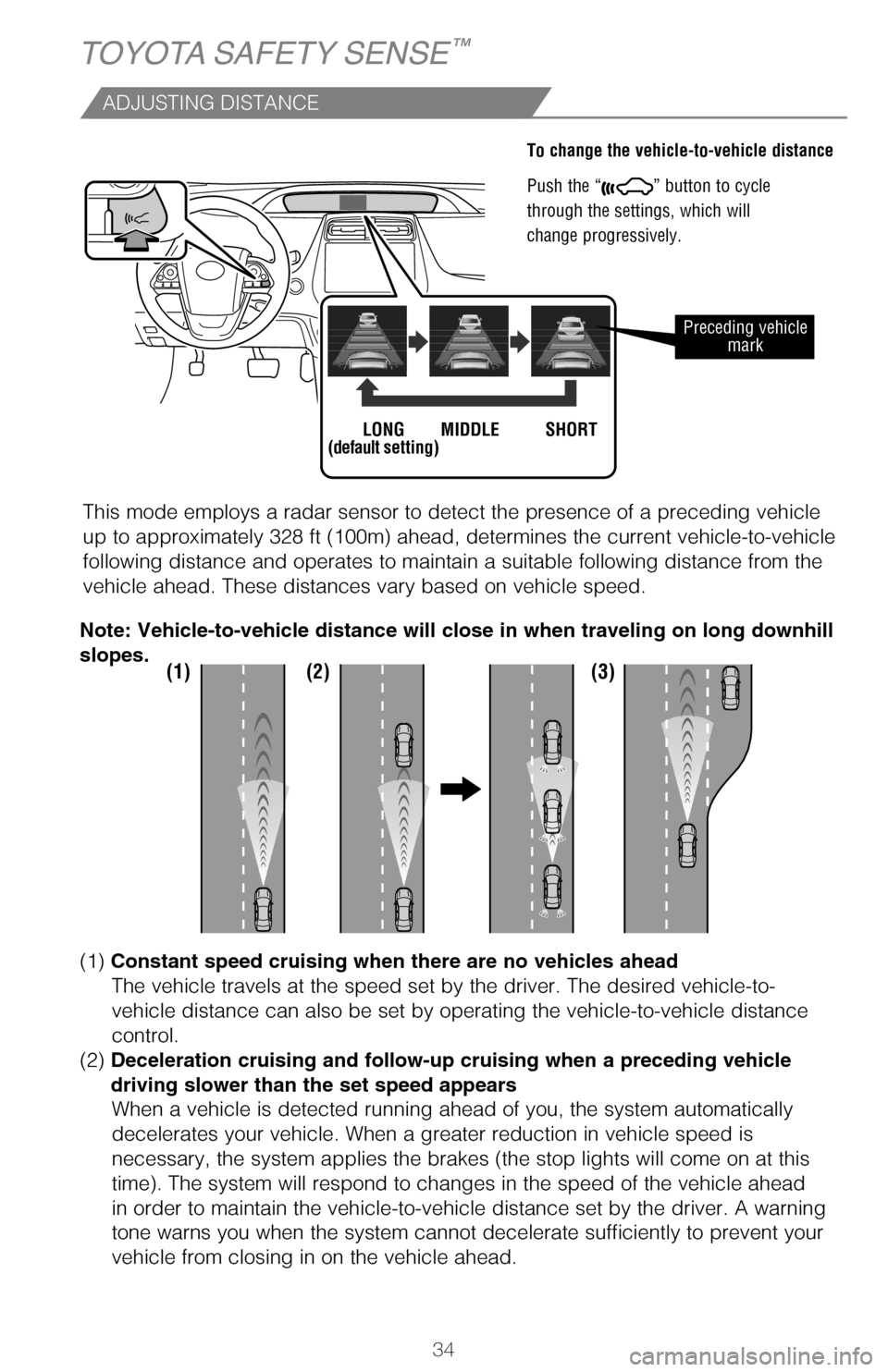
34
ADJUSTING DISTANCE
To change the vehicle-to-vehicle distance
Push the “
” button to cycle
through the settings, which will
change progressively.
This mode employs a radar sensor to detect the presence of a preceding v\
ehicle
up to approximately 328 ft (100m) ahead, determines the current vehicl\
e-to-vehicle
following distance and operates to maintain a suitable following distanc\
e from the
vehicle ahead. These distances vary based on vehicle speed.
Preceding vehicle mark
LONG
(default setting) MIDDLE SHORT
(1) (2) (3)
(1) Constant speed cruising when there are no vehicles ahead
The vehicle travels at the speed set by the driver. The desired vehicle-\
to-
vehicle distance can also be set by operating the vehicle-to-vehicle dis\
tance
control.
(2) Deceleration cruising and follow-up cruising when a preceding vehicle
driving slower than the set speed appears When a vehicle is detected running ahead of you, the system automaticall\
y
decelerates your vehicle. When a greater reduction in vehicle speed is
necessary, the system applies the brakes (the stop lights will come on \
at this
time). The system will respond to changes in the speed of the vehicle a\
head
in order to maintain the vehicle-to-vehicle distance set by the driver. \
A warning
tone warns you when the system cannot decelerate sufficiently to prevent your
vehicle from closing in on the vehicle ahead.
Note: Vehicle-to-vehicle distance will close in when traveling on long d\
ownhill
slopes.
TOYOTA SAFETY SENSE™
SWITCHING TO CONSTANT SPEED CONTROL MODE
Note: When your vehicle is too close to a vehicle ahead, and suf�cien\
t
automatic deceleration via the cruise control is not possible, the displ\
ay will
�ash and the buzzer will sound to alert the driver. An example of thi\
s would be
if another driver cuts in front of you while you are following a vehicle\
. Depress
the brake pedal to ensure an appropriate vehicle-to-vehicle distance.
If you are already using DRCC “
”, push ON-OFF button to turn the system off
first, then push and hold ON-OFF button for at least 1.5 seconds to switch.
Note: When the engine is turned off, it will automatically default to DR\
CC.
Refer to a Toyota Owner’s Manual for additional information on DRCC o\
peration,
settings adjustments, limitations, and precautions before attempting to \
use it.
(3) Acceleration when there are no longer any preceding vehicles driving
slower than the set speed The system accelerates until the set speed is reached. The system then
returns to constant speed cruising.
2017_Prius_D6_1.indd 349/25/16 2:38 AM
Page 37 of 56
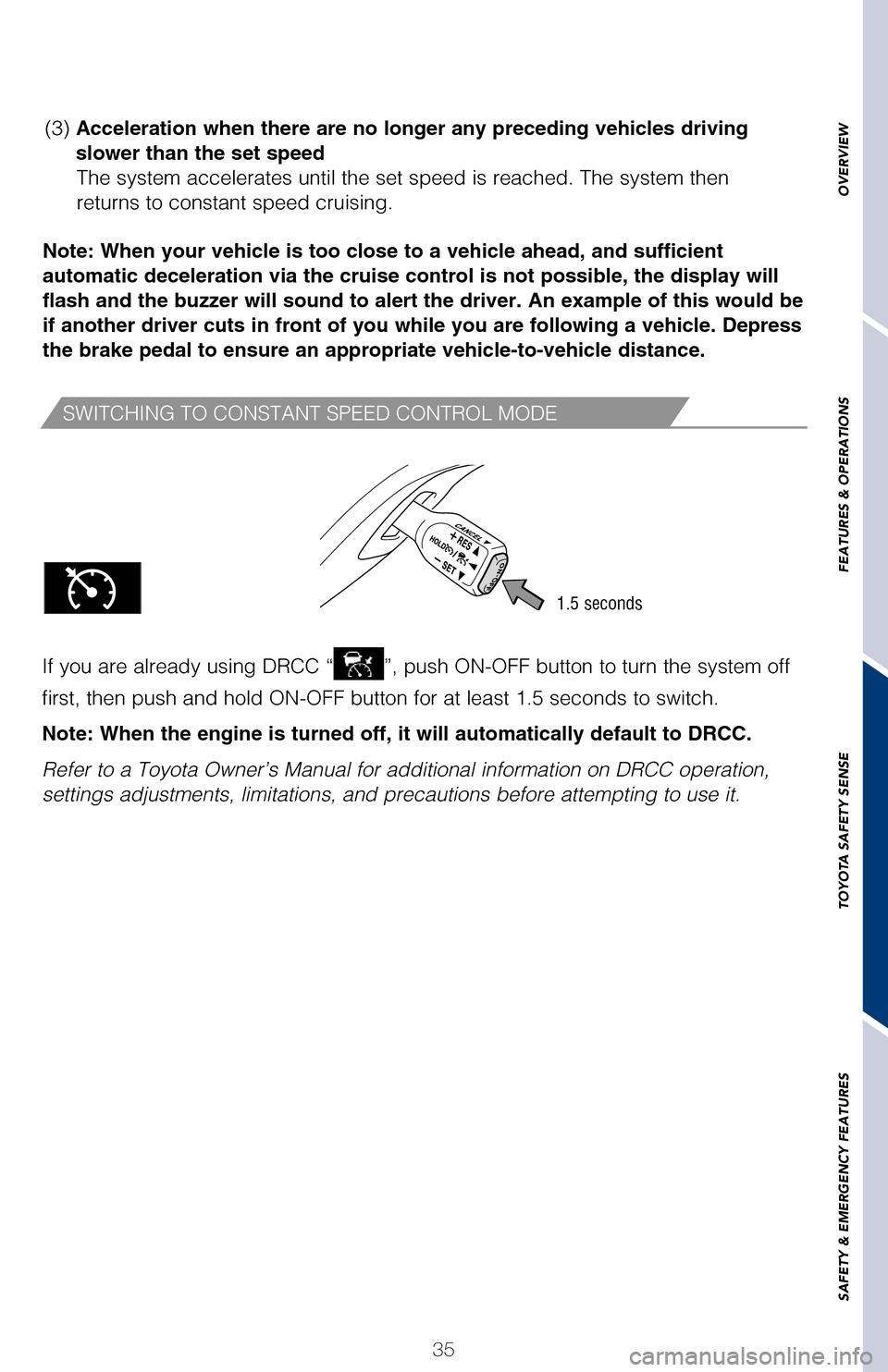
OVERVIEW
FEATURES & OPERATIONS
TOYOTA SAFETY SENSE
SAFETY & EMERGENCY FEATURES
35
To change the vehicle-to-vehicle distance
Push the “
” button to cycle
through the settings, which will
change progressively.
This mode employs a radar sensor to detect the presence of a preceding v\
ehicle
up to approximately 328 ft (100m) ahead, determines the current vehicl\
e-to-vehicle
following distance and operates to maintain a suitable following distanc\
e from the
vehicle ahead. These distances vary based on vehicle speed.
Preceding vehicle mark
(1) Constant speed cruising when there are no vehicles ahead
The vehicle travels at the speed set by the driver. The desired vehicle-\
to-
vehicle distance can also be set by operating the vehicle-to-vehicle dis\
tance
control.
(2) Deceleration cruising and follow-up cruising when a preceding vehicle
driving slower than the set speed appears
When a vehicle is detected running ahead of you, the system automaticall\
y
decelerates your vehicle. When a greater reduction in vehicle speed is
necessary, the system applies the brakes (the stop lights will come on \
at this
time). The system will respond to changes in the speed of the vehicle a\
head
in order to maintain the vehicle-to-vehicle distance set by the driver. \
A warning
tone warns you when the system cannot decelerate sufficiently to prevent your
vehicle from closing in on the vehicle ahead.
Note: Vehicle-to-vehicle distance will close in when traveling on long d\
ownhill
slopes.
SWITCHING TO CONSTANT SPEED CONTROL MODE
Note: When your vehicle is too close to a vehicle ahead, and suf�cien\
t
automatic deceleration via the cruise control is not possible, the displ\
ay will
�ash and the buzzer will sound to alert the driver. An example of thi\
s would be
if another driver cuts in front of you while you are following a vehicle\
. Depress
the brake pedal to ensure an appropriate vehicle-to-vehicle distance.
If you are already using DRCC “
”, push ON-OFF button to turn the system off
first, then push and hold ON-OFF button for at least 1.5 seconds to switch.
Note: When the engine is turned off, it will automatically default to DR\
CC.
Refer to a Toyota Owner’s Manual for additional information on DRCC o\
peration,
settings adjustments, limitations, and precautions before attempting to \
use it.
1.5 seconds
(3) Acceleration when there are no longer any preceding vehicles driving
slower than the set speed The system accelerates until the set speed is reached. The system then
returns to constant speed cruising.
2017_Prius_D6_1.indd 359/25/16 2:38 AM